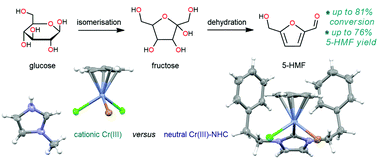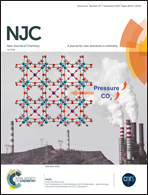Base-free glucose dehydration catalysed by NHC-stabilised heterohalo cyclopentadienyl Cr(iii) complexes†
Abstract
A range of five air-stable heterohalo Cr(III)–NHC complexes (1–5) have been synthesised from chromocene and the corresponding imidazolium salts. Employment of an N-4-NO2-benzyl imidazolium salt led to a side reaction where C–N bond cleavage occurred to form an imidazolium Cr(III) complex salt (6). The electrochemical processes of all six complexes were studied by means of cyclic voltammetry and a detailed conformational DFT analysis, which showed metal-centred redox behaviour. Furthermore, the Cr(III) complex salt (6) was electrochemically oxidised to Cr(IV) and electrochemically reduced to Cr(II) more readily than the related Cr(III)–NHC complexes (1–5). All complexes (1–6) were active (up to 81% conversion) as catalysts in the dehydration of glucose to form 5-hydroxymethylfurfural in moderate yields (up to 76%). This homogeneous system does not require oxidants or stoichiometric amounts of strong bases such as KOtBu, as often required in related catalytic systems, which is important for the development of greener catalytic processes employing naturally abundant precursors.



 Please wait while we load your content...
Please wait while we load your content...